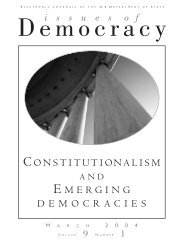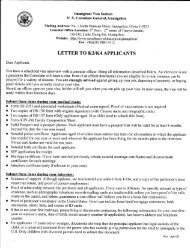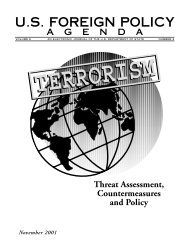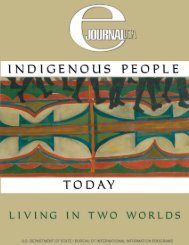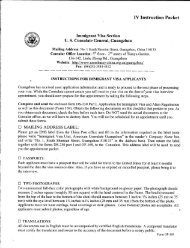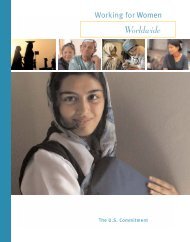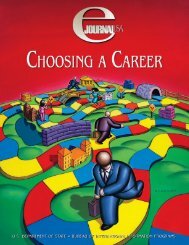s. history us history us history - Embassy of the United States
s. history us history us history - Embassy of the United States
s. history us history us history - Embassy of the United States
- No tags were found...
You also want an ePaper? Increase the reach of your titles
YUMPU automatically turns print PDFs into web optimized ePapers that Google loves.
CHAPTER 11: THE NEW DEAL AND WORLD WAR IIunionizing campaign, rebuilding <strong>the</strong> UMW’s declining membership from150,000 to over 500,000 within a year.Lewis was eager to get <strong>the</strong> AFL, where he was a member <strong>of</strong> <strong>the</strong> ExecutiveCouncil, to launch a similar drive in <strong>the</strong> mass production ind<strong>us</strong>tries. But<strong>the</strong> AFL, with its historic foc<strong>us</strong> on <strong>the</strong> skilled trade worker, was unwilling todo so. After a bitter internal feud, Lewis and a few o<strong>the</strong>rs broke with <strong>the</strong> AFLto set up <strong>the</strong> Committee for Ind<strong>us</strong>trial Organization (CIO), later <strong>the</strong> Congress<strong>of</strong> Ind<strong>us</strong>trial Organizations. The passage <strong>of</strong> <strong>the</strong> National Labor Relations Act(NLRA) in 1935 and <strong>the</strong> friendly attitude <strong>of</strong> <strong>the</strong> National Labor RelationsBoard put <strong>the</strong> power and authority <strong>of</strong> <strong>the</strong> federal government behind <strong>the</strong> CIO.Its first targets were <strong>the</strong> notorio<strong>us</strong>ly anti-union auto and steel ind<strong>us</strong>tries.In late 1936 a series <strong>of</strong> sit-down strikes, orchestrated by <strong>the</strong> fledgling <strong>United</strong>Auto Workers union under Walter Reu<strong>the</strong>r, erupted at General Motors plantsin Cleveland, Ohio, and Flint, Michigan. Soon 135,000 workers were involvedand GM production ground to a halt.With <strong>the</strong> sympa<strong>the</strong>tic governor <strong>of</strong> Michigan ref<strong>us</strong>ing to evict <strong>the</strong> strikers,a settlement was reached in early 1937. By September <strong>of</strong> that year, <strong>the</strong> <strong>United</strong>Auto Workers had contracts with 400 companies involved in <strong>the</strong> automobileind<strong>us</strong>try, assuring workers a minimum wage <strong>of</strong> 75 cents per hour and a 40-hour work week.In <strong>the</strong> first six months <strong>of</strong> its existence, <strong>the</strong> Steel Workers OrganizingCommittee (SWOC), headed by Lewis lieutenant Philip Murray, picked up125,000 members. The major American steel company, U.S. Steel, realizingthat times had changed, also came to terms in 1937. That same year <strong>the</strong> SupremeCourt upheld <strong>the</strong> constitutionality <strong>of</strong> <strong>the</strong> NLRA. Subsequently, smallercompanies, traditionally even more anti-union than <strong>the</strong> large corporations,gave in. One by one, o<strong>the</strong>r ind<strong>us</strong>tries — rubber, oil, electronics, and textiles— also followed suit.The rise <strong>of</strong> big labor had two major long-term impacts. It became <strong>the</strong>organizational core <strong>of</strong> <strong>the</strong> national Democratic Party, and it gained materialbenefits for its members that all but erased <strong>the</strong> economic distinction betweenworking-class and middle-class America.In <strong>the</strong> depths <strong>of</strong> <strong>the</strong> Great Depression, March 1933, anxio<strong>us</strong> depositors line upoutside <strong>of</strong> a New York bank. The new president, Franklin D. Roosevelt,had j<strong>us</strong>t temporarily closed <strong>the</strong> nation’s banks to end <strong>the</strong> drain on <strong>the</strong>banks’ reserves. Only those banks that were still solvent were permittedto reopen after a four-day “bank holiday.”T U R M O I L A N DCHANGEA P I C T U R E P R O F I L EFor <strong>the</strong> <strong>United</strong> <strong>States</strong>, <strong>the</strong> 20th century was a period <strong>of</strong> extraordinaryturmoil and change. In <strong>the</strong>se decades, <strong>the</strong> nation endured <strong>the</strong> worsteconomic depression in its <strong>history</strong>; emerged triumphant, with <strong>the</strong>Allies, in World War II; assumed a role <strong>of</strong> global leadership in <strong>the</strong>century’s twilight conflict known as <strong>the</strong> Cold War; and underwent aremarkable social, economic, and political transition at home. Whereonce <strong>the</strong> <strong>United</strong> <strong>States</strong> transformed itself over <strong>the</strong> slow march <strong>of</strong>centuries, it now seemed to reinvent itself almost by decades.228 229



